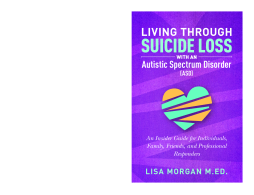
Additional Information
Book Details
Abstract
Losing someone to suicide can open up a world of pain, confusion and grief, and for people with ASDs, the effect can be acute and extremely challenging. Reaching out to fellow Aspies, Lisa Morgan proffers her insight and advice to ensure that others on the autism spectrum don't have to face suicide loss alone.
Written from a first-hand account, this astonishingly honest book looks at the immediate aftermath, and how emergency responders can help, as well as the long-term implications of living with suicide loss for individuals on the autism spectrum. The book describes common difficulties after experiencing suicide loss, such as beginning to comprehend the death of a loved one and managing their estate, as well as matters more specific to people on the autism spectrum, such as overstimulated sensory issues and difficulties with misunderstandings and miscommunication at an already chaotic time. The book will also help those who aren't on the autism spectrum to understand how best to help someone with autism who is coping with suicide loss, as well as what not to do.
Lisa compassionately, courageously and incisively offers the reader the wisdom and learnings she earned through experiencing the tragic loss of her husband to suicide. I can highly recommend this book to anyone on the autism spectrum bereaved by suicide and to their support network. The reader will discover distilled wisdom and strategies for each part of their own journey.
Dr Michelle S. Garnett (BPsych(Hons), MPsych(Clin), PhD (Psych) MAPS MCCP), Clinic Director and Clinical Psychologist, Minds & Hearts Clinic, Brisbane, Australia
Living Through Suicide Loss is a valuable addition to suicide grief literature. Morgan's account of the challenges she faced, following her husband's death, will resonate deeply with all suicide loss survivors. The special challenges she documented as someone with Asperger's syndrome, will sensitize and empower all involved in such tragedies.
Ronnie Susan Walker MS, LCPC, Founder: Alliance of Hope for Suicide Loss Survivors
The excellent and much-needed book deals with the specific issues - emotional and practical - faced by people on the autism spectrum when a loved one completes suicide. Written from a personal, lived experience perspective, this sensitive and valuable book validates the experience of readers and helps them to manage what is essentially unmanageable.
Jeanette Purks, autism self-advocate and author of The Guide to Good Mental Health on the Autism Spectrum
Anyone on the spectrum who has experienced a suicide in their family, a crisis which involved the police or other authorities, medical emergencies and the like, can relate to this book. Similarly this is a book the emergency service providers should read too because those in the helping professions aren't actually helping us, when they use their usual methods. But, this is not a clinical how-to. This is a detailed, emotional and vivid account, almost a play-by-play, of the events which transpired from the moment of that fateful phone call. Behind the events, the physical movements, are the thoughts and reactions that only another person on the autism spectrum can truly understand, but everyone should try. A heart-wrenching, honest account of the kind of experience that no one should have to go through, but, unfortunately many of us do.
Rudy Simone, author of the A-Z of ASDs: Aunt Aspie’s Guide to Life
Table of Contents
| Section Title | Page | Action | Price |
|---|---|---|---|
| Living Through Suicide Loss with an Autistic Spectrum Disorder (ASD) by Lisa Morgan | 3 | ||
| Foreword by Dr. Carla Stumpf Patton | 9 | ||
| Acknowledgments | 14 | ||
| Preface | 16 | ||
| Chapter One - June 24, 2015 | 21 | ||
| Chapter Two - The Aftermath Begins | 41 | ||
| Chapter Three - Where Did Everyone Go? | 65 | ||
| Chapter Four -Support | 79 | ||
| Chapter Five - Sensory Issues and Emotions | 99 | ||
| Chapter Six - Strengths | 109 | ||
| Chapter Seven - A New Life | 117 | ||
| Chapter Eight - Time Goes On | 125 | ||
| Chapter Nine - Conclusion | 135 | ||
| Help for Suicide Prevention, Intervention, and Postvention | 137 | ||
| Index | 141 |
